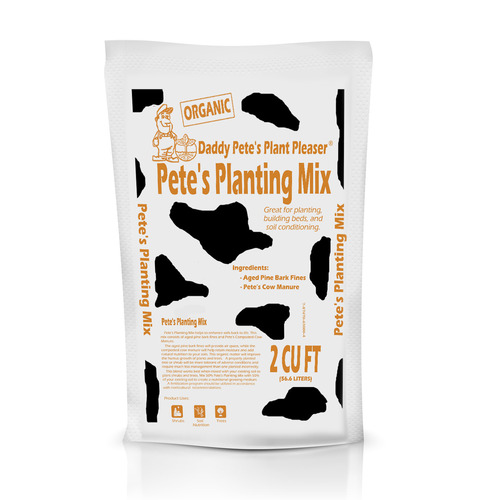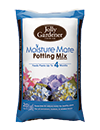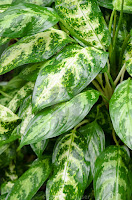In a world full of bagged soils, each one claiming to be better than the next. You may be left in a cloud of dirt and confusion. After all, it's dirt. Why does it have to be so complicated?
Most people don't look at the ingredients of the bag. Again, it's dirt! Believe it or not, every soil that is marketed has a different set of ingredients that makes it good for some uses and maybe not so good for others. But, chances are you never thought about that. If its intended use is not in its title then most assume it's good for all things. The reality is, the names and titles are vague at best. Potting mix, potting soil, planting mix, garden soil, it all seems very ambiguous at best.
Here at the nursery, we have many different types of soil as well, but we want to take a moment to explain the difference so you can make an informed decision. There are many additives you can purchase to combine with existing soil to make it more hospitable for new plantings. Understanding your needs is key to making a great home for new roots.
We carry Daddy Pete's soils and Jolly Gardener products as well.
Daddy Pete's is a local company and we try to support local as much as we can. Without local businesses, Mainstreet America will fade into the past. But, that's a blog for another time.
Planting Mix

Planting mix, generally speaking, is a mixture of composted cow manure and finely ground pine bark. The combination of this composted organic matter makes the soil very nutrient-rich so it is a superb choice for adding to the native soil when planting trees and shrubs or enriching the soil of a tired flower bed or garden spot. It also helps with drainage and water penetration.
Lawn and Garden Soil

This is a combination of composted manure, finely ground pine bark, sand, and garden gypsum (calcium sulfate). This is a good choice for amending gardens and raised beds which may have exhausted the nutrients from the soil and need some revitalization.
Raised Bed Mix

This is a well-balanced combination of composted cow manure, finely ground pine bark, sand, perlite, and gypsum (calcium sulfate). As the name says it is best used in raised beds and containers or vegetable gardens as it promotes good drainage and nutrients for good growth.
Moisture Mate* Planting Mix

Moisture Mate is a Jolly Gardener product that is used for containers. It contains polymer crystals that help to maintain moisture in containers. It also helps prevent over-watering with its superb drainage properties. Moisture Mate also contains timed release plant food that will feed your new plantings for up to four months.
Perlite
per·lite
/ˈpərlīt/noun
- a form of obsidian characterized by spherlulites formed by cracking of the volcanic glass during cooling, used as insulation or in plant growth media.
While widely used as a soil amendment for planting, it has become popular as a stand-alone planting medium for hydroponic growing. acting as more of a support for the plants while keeping the tops of the plants relatively dry, thereby preventing rot.
Vermiculite
ver·mic·u·lite
/vərˈmikyəˌlīt/noun
- a yellow or brown mineral found as an alteration product of mica and other minerals, used for insulation or as a moisture-retentive medium for growing plants.
Vermiculite is widely used as an additive in soil because of its water retention properties. Making it supreme for plants that need a lot of moisture. You can purchase this separately to add to existing or native soil or you can purchase bagged soil that already has it added. Percentages of content can usually be found on the outside of the bag.
Peat Moss
Peat Moss is an organic decomposed moss with extremely good water retention properties. Peat moss is added to soil that has a high sand content so that it can aid in keeping the soil moist and loose. Most bagged soils have some percentage of peat moss added. check your ingredients. the higher the Sphagnum content, the more water that will be retained in your pot or area. Peat moss can be added to your native soil to keep it more workable for planting.
Composted Cow manure

You really don't want to put fresh manure on a new bed or garden just before you plant but you can add it for the next season. However, you can buy composted cow manure by the bag and add it just before planting to act as a fertilizer for your plants. It is no secret that any composted organic matter makes your soil more nutrient-rich and gives your young plants the solid start they need.
In short, you can purchase bagged soils that already have what you need, or you can purchase additives to make your existing soil better. I recommend that very poor soil be amended with bagged soil when planting new shrubs and trees. and occasionally to beds and gardens. If you have already used some bagged soil in your area and just need to freshen it up, you can add a singular additive based on your needs. Or find the perfect combination for your plans. Either way, it is good practice to know what the needs of your plants are, then make your purchase based on that. The key to successful gardening starts at ground level. Soil is key to plant health and crop abundance.
Get in the dirt, good dirt looks rich and feels food to the fingers and the soul.
HAPPY GARDENING!
HAPPY GARDENING!










